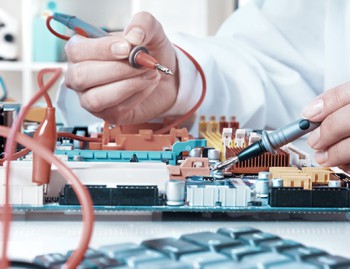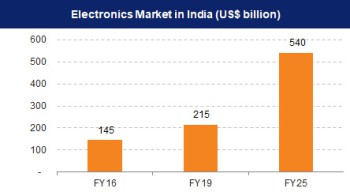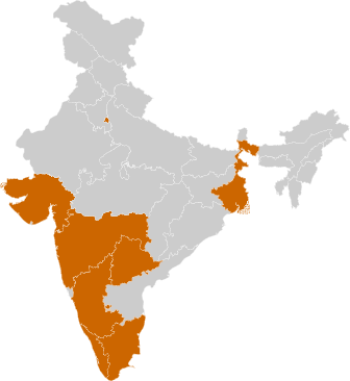INTRODUCTION
India witnessed a substantial spike in demand for electronic products in the last few years; this is mainly attributed to India's position as second-largest mobile phone manufacturer worldwide and surge in internet penetration rate. The Government of India attributes high priority to electronics hardware manufacturing, as it is one of the crucial pillars of Make in India, Digital India and Start-up India programmes.
The Electronics System Design & Manufacturing (ESDM) sector plays a vital role in the government's goal of generating US$ 1 trillion of economic value from the digital economy by 2025. With various government initiatives aiming to boost domestic manufacturing, India has already started witnessing initial movement with increased production and assembly activities across products such as mobile phones and other consumer electronics.

MARKET SIZE

- The Indian electronics manufacturing industry is projected to reach US$ 520 billion by 2025.
- In December 2021 and January 2022, exports of electronic goods stood at US$ 1.64 billion and US$ 1.32 billion, respectively.
- In FY22 (until January 2022), imports of electronics goods stood at US$ 58.64 billion, whereas exports stood at US$ 12.38 billion. In FY21, the export of electronics stood at US$ 2.43 billion.
- The demand for electronic products will rise to US$ 400 billion by 2025 from US$ 33 billion in FY20.
- Electronics market has witnessed a growth in demand with market size increasing from US$ 145 billion in FY16 to US$ 215 billion in FY19—the market witnessed a growth of 14% CAGR from 2016-19.
- In FY20, imports accounted for US$ 50 billion, wherein China and Hong Kong accounted for ~US$ 28 billion, or ~57% of India’s total electronic imports.
- India's exports of electronic goods were valued at US$ 11.7 billion in FY21. In May 2021, exports of electronic goods were valued at US$ 950.17 million.
- In India, smartphone shipments reached 150 million units and 5G smartphone shipments crossed 4 million in 2020, driven by high consumer demand post-lockdown.
- Smartphone shipments in India increased by ~82% YoY to reach 33.0 million units in the second quarter of 2021. Xiaomi led the Indian smartphones market with 28.4%, followed by Samsung (17.7%).
- In Q3 2021 (from July to September), the smartphone shipments from India are expected to reach 52 million.
- The Electronics System Design & Manufacturing (ESDM) is broadly segregated into—electronics system and electronics design.
- Electronics system market is expected to witness 2.3x demand of its current size (FY19) to reach US$ 160 billion by FY25.
- Electronics design segment, growing at 20.1%, was 22% of the ESDM market size in FY19; it is anticipated to be 27% of the ESDM market size in FY25.
- In FY20, the production value of mobile devices reached US$ 30 billion from US$ 3 billion in FY15
- The consumer electronics and appliances industry in India is expected to become the fifth largest in the world by 2025.
INVESTMENTS
According to the Department for Promotion of Industry and Internal Trade, from April 2000 to June 2021, Foreign Direct Investment (FDI) equity inflows stood at US$ 3,176.29 million.
The following are some recent investments and key developments in the Indian electronics and ESDM sector:
- In March 2022, Reliance announced that it would invest US$ 220 million in a joint venture with Sanmina Corp, a US-listed company for making electronic products in Asian countries.
- According to sources, Apple Inc. in 2021 manufactures 70% of mobile phones sold in India, a sharp increase from 30% recorded two years ago. This is a significant push towards the "Make in India" initiative, following the government's Production-linked Incentive (PLI) plan, which began in FY21.
- In September 2021, tech giant Lenovo announced plans to ramp up manufacturing capabilities in India across various product categories, such as PCs, notebooks and smartphones, due to rising consumer demand. However, details of the investment were not disclosed.
- In September 2021, PG Electroplast, a contract manufacturer of electronic goods, announced that it had applied for a PLI scheme and pledged to invest Rs. 300 crore (US$ 40.47 million) towards the production of air conditioner components.
- Intel has invested over US$ 7 billion in design and R&D facilities in the country to date.
- The Tata Group announced plans to enter the semiconductor manufacturing business as of August 2021—seeking a proportion of the US$ 1 trillion high-tech electronics manufacturing sector.
- As of March 03, 2021, 19 companies have filed for the production-linked incentive (PLI) scheme for IT Hardware. The scheme was open for applications until April 30, 2021; its incentives will be available from April 01, 2021. Over the next four years, the scheme is expected to lead to total production of ~Rs. 160,000 crore (US$ 21.88 billion). Of the total production, IT hardware companies have proposed production of >Rs. 135,000 crore (US$ 18.46 billion); and domestic companies have proposed production of >Rs. 25,000 crore (US$ 3.42 billion).
- In April 2021, Japanese electronics brand AIWA, which registered its India subsidiary in February 2021, is relaunching with five products in the TWS (True Wireless Stereo) and audio segments at a total investment outlay of US$ 10 million for Phase-1 of operations.
- The government has set a target to get ~Rs. 18,000 crore (US$ 2.4 billion) investments in the electronics manufacturing segment by 2021-22.
- In January 2021, Panasonic Life Solutions India, a wholly-owned subsidiary of Panasonic Corporation, announced that it will invest Rs. 600 crore (US$ 82.34 million) to set a up a new electrical appliances manufacturing facility in Sri City, Andhra Pradesh.
- On February 16, 2021, Amazon announced that it will commence manufacturing of electronics products from India with Cloud Network Technology, a subsidiary of Foxconn in Chennai, later in the year. The device manufacturing programme will be able to produce 'Fire TV Stick' devices in large quantities every year, catering to demands of customers in India.
- In January 2021, boAt, an earphones and smart wearable manufacturer, received an investment of US$ 100 million from Warburg Pincus, a key private equity firm.
- In July 2021, C4V, a lithium-ion cell manufacturer in the US, invested >US$ 537.15 million in the electric battery manufacturing sector in Karnataka.
GOVERNMENT INITIATIVES
- About 80% of the Production-Linked Incentive scheme (PLI) to encourage manufacturing in the country, which covers 14 industries and has a total investment of Rs 3 lakh crore (US$ 38.99 billion), is mainly focused on three major sectors: electronics, automobiles, and solar panel production.
- PLI scheme for large scale electronics manufacturing launched by Ministry of Electronics and Information Technology (MeitY) in April 2020 has been extended from existing five-year band (FY21-FY25) to six-year (FY21-FY26).
- In September 2021, India started discussions with Taiwan to alleviate the global semiconductor chip shortage. According to an exclusive Bloomberg report, this may bring chip production to South Asia by end-2021, coupled with tariff reductions on components used to make semiconductors. Officials from New Delhi and Taipei recently negotiated a proposal to set up a semiconductor facility worth US$ 7.5 billion in India; the facility will supply everything from 5G devices to electric cars.
- In September 2021, the Indian Institute of Technology Indore and the Confederation of Indian MSME in Electronics System Design and Manufacturing (ESDM) and Information Technology (CIMEI), signed a Memorandum of Understanding (MoU) to collaborate and share knowledge and best practices as well as offer technological support for the growth of Indian start-ups and SMEs.
- In May 2021, the cabinet, chaired by the Prime Minister Mr. Narendra Modi, approved a proposal by the Department of Heavy Industries and Public Enterprises to implement the production-linked incentive (PLI) scheme 'National Programme on Advanced Chemistry Cell (ACC) Battery Storage' to achieve manufacturing capacity of 50 GWh (Giga Watt Hour) of ACC and 5 GWh of 'Niche' ACC, with an outlay of Rs. 18,100 crore (US$ 2.47 billion).
- As per Union Budget 2021-22, the Ministry of Electronics and Information Technology (MeitY) has been allocated Rs. 9,720.66 crore (US$ 1.33 billion). In the allocated budget, revenue expenditure allocation is Rs. 9,274.66 crore (US$ 1.27 billion) and capital expenditure allocation is Rs. 446 crore (US$ 61.34 million).
- The key government initiatives such as 'Make in India' and 'Digital India' improved the country's EoDB. In 2021-22, the total budget allocation towards the 'Digital India' programme is Rs. 6,806.33 crore (US$ 936.19 million).
- In January 2021, the India Cellular and Electronics Association (ICEA) proposed a RoDTEP rate of 2% on smartphones, 2.4% on featurephones, 2% on tablets/laptops, 3.4% on battery chargers and 1.48% on battery packs.
- In December 2020, the Government of India issued expression of interest (EoI) to set up or expand the existing semiconductor wafer/ device fabrication (FAB) facilities in the country or acquire semiconductor FABs overseas.
- To accelerate quantum computing-led research & development and enable new scientific discoveries, the Ministry of Electronics and Information Technology (MeitY), in collaboration with Amazon Web Services (AWS), will establish a quantum computing applications lab in the country.
- On November 11, 2020, Union Cabinet approved the production-linked incentive (PLI) scheme in 10 key sectors (including electronics and white goods) to boost India's manufacturing capabilities, exports and promote the 'Atmanirbhar Bharat' initiative.
- On December 02, 2020, 'Hubli ESDM Exchange' (HEX), an incubation centre for the development of electronic device design (ESDM), backed and funded by the state government's Karnataka Innovation & Technology Services (KITS) and managed by the India Electronics & Semiconductor Association (IESA), was launched at the KLE Tech Park of the KLE Technical University (KLETU) in Hubballi.
- A fund of Rs. 3.2 crore (US$ 433.46 thousand) for three years has been approved by the Department of Electronics, IT, BT, Science & Technology.
- Under the PLI scheme for IT Hardware, the approved enterprises are estimated to manufacture equipment worth >US$ 21.62 billion over the next four years. Of the total production, foreign companies have suggested production worth US$ 11.38 billion, whereas domestic enterprises have planned a production of US$10.20 billion.
ROAD AHEAD
Fueled by strong policy support, huge investments by public and private stakeholders and a spike in demand for electronic products, the ESDM sector in India is predicted to reach US$ 220 billion by 2025, expanding at 16.1% CAGR between 2019 and 2025.
References:Media reports, Ministry of Electronics and Information Technology (MeitY), Make in India, Invest India, Union Budget 2021-22
Disclaimer: This information has been collected through secondary research and IBEF is not responsible for any errors in the same

ESDM Clusters
- Madhya Pradesh
- Andhra Pradesh
- Punjab
- Kerala
- Tamil Nadu
- Uttar Pradesh

Industry Contacts
- India Electronics & Semiconductor Association
- Consumer Electronics and Appliances Manufacturers Association
- Electronic Industries Association of India
- NASSCOM